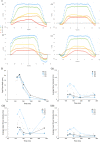Does transcatheter aortic valve alignment matter?
- PMID: 31803486
- PMCID: PMC6887501
- DOI: 10.1136/openhrt-2019-001132
Does transcatheter aortic valve alignment matter?
Erratum in
-
Correction: Does transcatheter aortic valve alignment matter?Open Heart. 2019 Dec 31;6(2):e001132corr1. doi: 10.1136/openhrt-2019-001132corr1. eCollection 2019. Open Heart. 2019. PMID: 32076557 Free PMC article.
Abstract
Objective: This study investigates the effect of transcatheter aortic valve (TAV) angular alignment on the postprocedure haemodynamics. TAV implantation has emerged as an effective alternative to surgery when treating valve dysfunction. However, the benefit of avoiding surgery is paid back by the inability to remove the native diseased leaflets and accurately position the device in relation to the aortic root, and the literature has shown the root anatomy and substitute position can play an essential role on valve function.
Methods: A commercial TAV was placed in a silicone mock aortic root in vitro, including mock native leaflets, and either aligned commissure-to-commissure or in maximum misalignment. Haemodynamic performance data at various stroke volumes were measured, and Particle Image Velocimetry analysis was performed at a typical stroke volume for rest conditions. The two configurations were also studied without mock native leaflets, for comparison with previous in vitro studies.
Results: Haemodynamic performance data were similar for all configurations. However, imaging analysis indicated that valve misalignment resulted in the central jet flow not extending to the root wall in the native commissures' vicinity, replaced by a low shear flow, and a reduction of upper sinus flow of 40%, increasing flow stagnation in the sinus.
Conclusions: TAV misalignment did not result in a significant change in valve hydrodynamic performance, but determined some change in the fluid flow patterns, which may promote pathological scenarios, such as increased thrombogenicity of blood flow within the sinuses of Valsalva, and plaque formation around the lumen of the sinotubular junction.
Keywords: transcatheter aortic valve; valsalva sinuses; valve alignment.
© Author(s) (or their employer(s)) 2019. Re-use permitted under CC BY-NC. No commercial re-use. See rights and permissions. Published by BMJ.
Conflict of interest statement
Competing interests: None declared.
Figures







References
-
- Binder RK, Leipsic J, Wood D, et al. . Prediction of optimal deployment projection for transcatheter aortic valve replacement: angiographic 3-dimensional reconstruction of the aortic root versus multidetector computed tomography. Circ Cardiovasc Interv 2012;5:247–52. 10.1161/CIRCINTERVENTIONS.111.966531 - DOI - PubMed
Publication types
Grants and funding
LinkOut - more resources
Full Text Sources
Other Literature Sources
